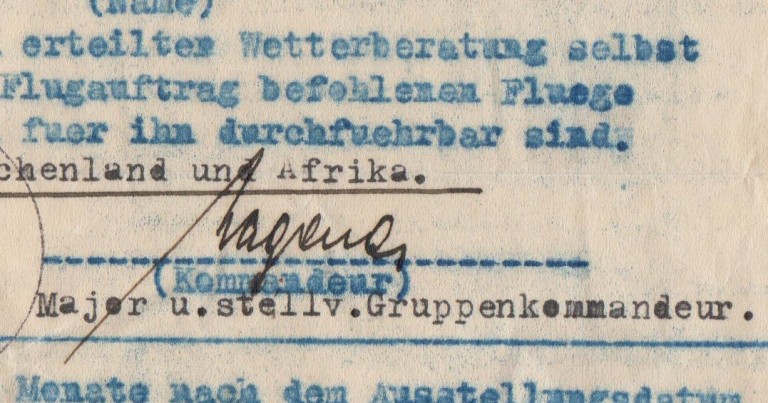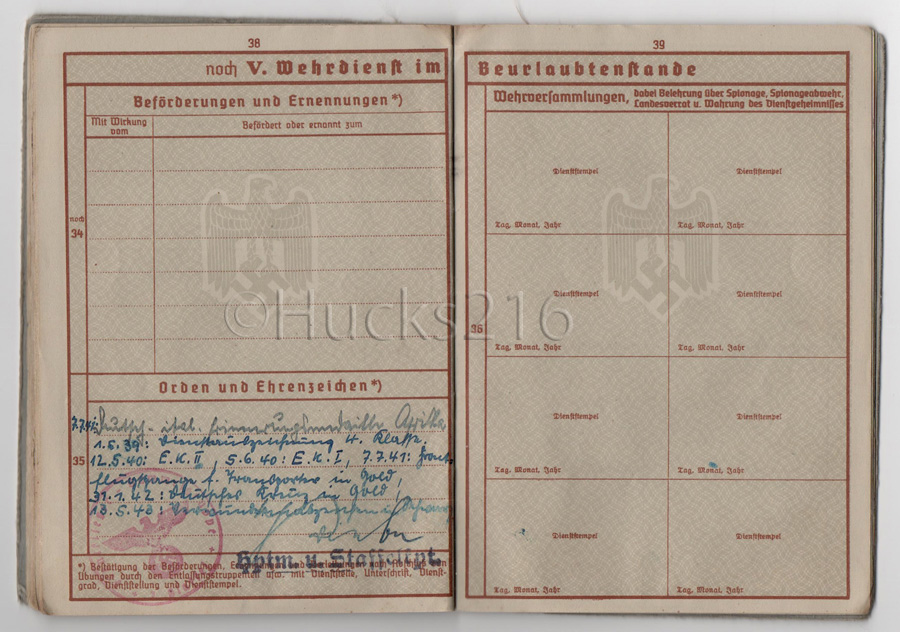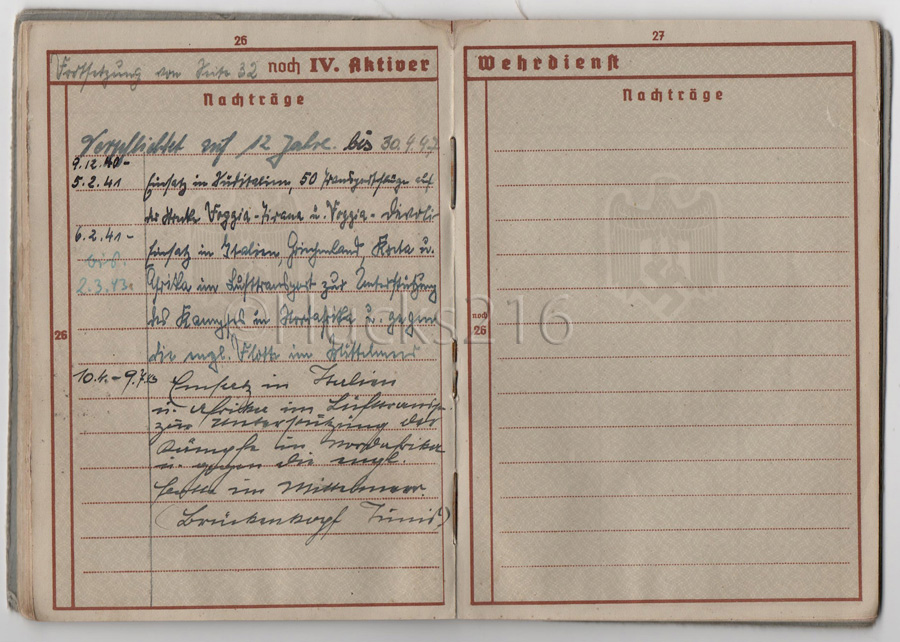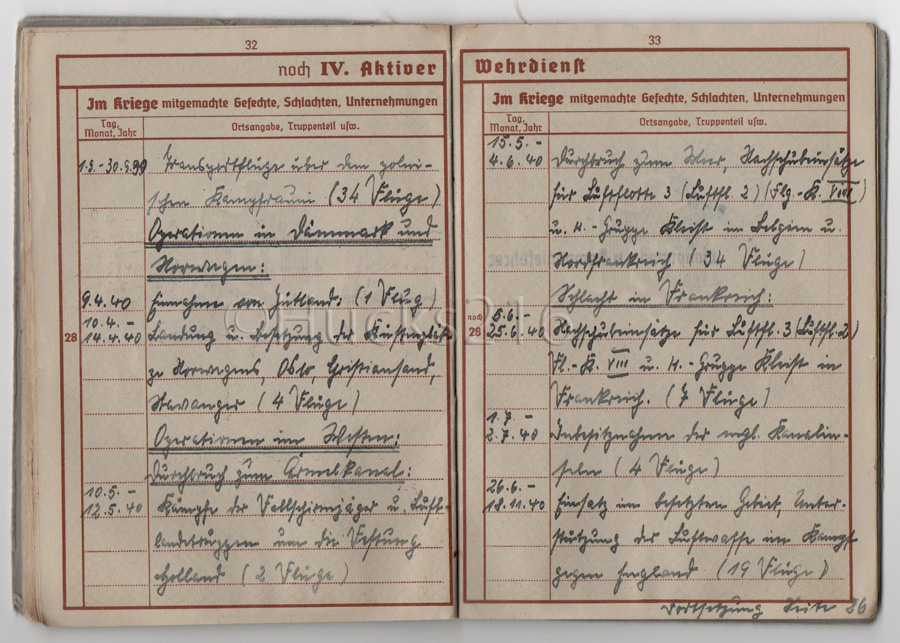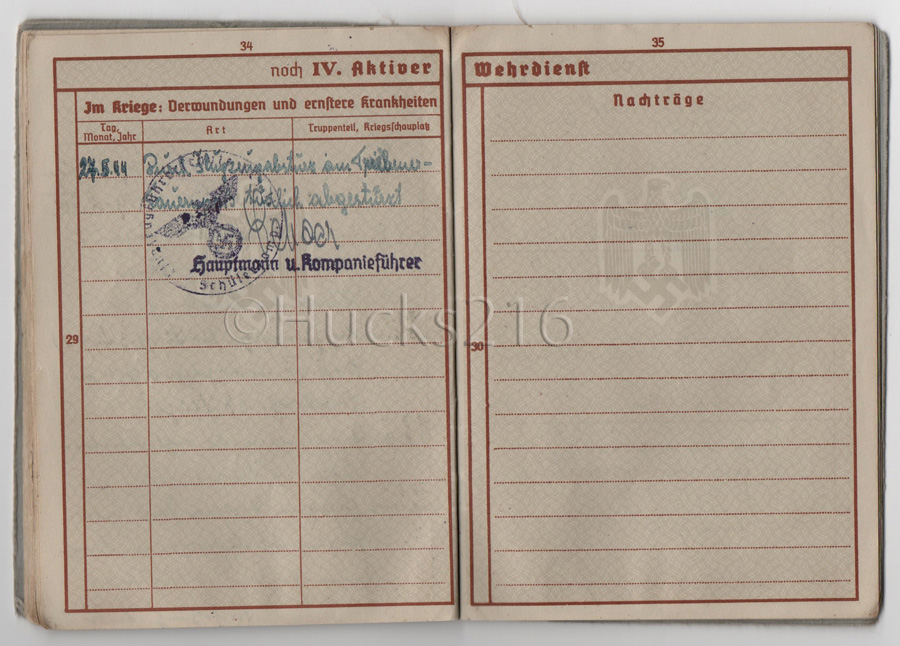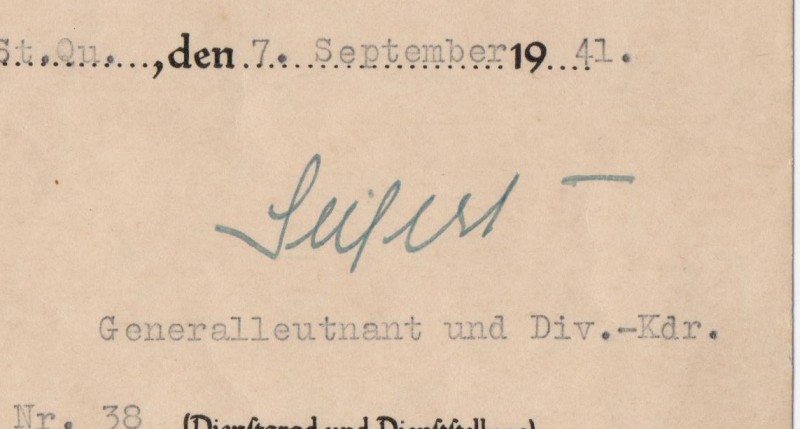-
Posts
3,680 -
Joined
-
Last visited
-
Days Won
9
Content Type
Profiles
Forums
Blogs
Gallery
Events
Store
Everything posted by hucks216
-
But that might be because they don't carry a record of their service around with them during their service time whereas a Soldbuch was carried on their person at all times and the Militärpaß was kept at a HQ. But if they were handed in and archived were the majority destroyed during any one of the Allied bombing raids?
-
This is just a question to satisfy my curiosity. Maybe I am looking in the wrong places and being a TR paperwork collector that is entirely possible but do WW-1 Soldbücher or Militärpaße exist in collections or come on the market for high ranking officers? I am not looking to buy any but in the past few years I have seen tons of TR related General rank related equivalents but not one for a WW-1 General/Admiral ranked officer. Were they even issued such a thing (I would imagine so as they obviously didn't start off as a General) or did they hand it in when they reached a certain rank and get issued something else? Same goes for major Naval units - do any ever appear for sailors who served on the heavy units at battles such as Jutland, Dogger Bank, the coastal raids etc?
-
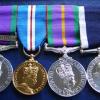
Seeking Info on Kriegsmarine 1944 EK.2
hucks216 replied to dpast32's topic in Germany: All Eras: The Iron Cross
Or she might ask/demand to have the citation returned to her. -
I must admit that I was surprised that he still discounted it after learning of the signature but fair play to him for doing so. I wonder if this particular man was aware of the conspiracy overtones in the Abwehr and considering the signature he obviously had contact with certain members of it, and if so what were his feelings towards it and were those feelings reinforced after seeing what happened at Dulag 121 or was he completely in the dark about everything (maybe he was viewed as untrustworthy by the conspirators) and Dulag 121 just strengthened his beliefs in favour of the regime?
-
Don't think it is a flotilla emblem, at least not U-boat flotilla. Could be a U-Boat emblem but over 800 U-Boats had emblems so narrowing it down could be difficlut. Alternatively it cold be the emblem chosen by a Cadet course after they had joined the Kriegsmarine. Here is a list of the U-Boats that are known to have had an emblem... http://www.uboat.net/special/emblems/listing_boats.html
-

Seeking Info on Kriegsmarine 1944 EK.2
hucks216 replied to dpast32's topic in Germany: All Eras: The Iron Cross
Try getting hold of a copy of Schnellboote by Lawrence Paterson. It's on Amazon and is in English. But to be honest, the website I posted a link to earlier goes into more depth than any book on the subject I know. S-188 belonged to 4.Schnellbooteflottille. -

Seeking Info on Kriegsmarine 1944 EK.2
hucks216 replied to dpast32's topic in Germany: All Eras: The Iron Cross
Look in the top left corner of the EK citation - that could well be his E-Boat (S-188). While the KM didn't always type the man's unit like the Heer did, they did often write the unit in the top corner in pencil. Taken from the link I posted previously (I've put in bold & underlined the two relevant parts, i.e. the date and the boat mentioned)... During the night 09./10.06.1944 the boats had the same orders. The 5. and the 9. SFltl, however, were stuck in an escort circle off Cape Barfleur, while the 4. SFltl could lay mines on the convoy route and was involved in fights with destroyers. "S 188" reported a toprdo hit on a ferry of 5000 BRT. "S 172" and "S 187" reported hits on two freighters of 2000 BRT each. "S 190" and "S 180" transfered from Vlissingen to Boulogne with the 8. SFltl. In so doing "S 190" took a mine hit, which caused no harm to her personnel and no leakage. But the boat had to be docked, that is why the unit went to Rotterdam. The 2. SFltl reported the sinking of two freighters of 900 and 1500 BRT respectively and entered the harbour of Le Havre. S-188 was sunk on 14th June 1944 in Le Havre... During the night 13./14.06.1944 the boats were again to attack the landing fleet, the 5. and the 9. SFltl were to sail to Cherbourg afterwards because of the concentration of boats on Le Havre. Wind from northwest with force seven forced the boats of the 4., 5., and 9. SFltl to call off the operation and to return to Le Havre. The radio traffic was intercepted and decifered and the Allied attacked the boats in the evening of the 14.06.1944 by 221 Lancaster-bombera escorted by fighters and Mosquitos. 14 S-boats ("S 84", "S 100", "S 138", "S 142", "S 143", "S 144", "S 146", "S 150", "S 169", "S 171", "S 172", "S 173", "S 187", "S 188") and three of the four torpedoboats in harbour were sunk, only "S 167" escaped by leaving harbour. He could of got the EK II for a single act or more likely for a combination of missions and surviving the sinking. EK's weren't just awarded for acts of bravery. They could also be awarded as a percentage, i.e. such & such unit is to award 10% of their men with an EK II and 2% with an EK I. -

Seeking Info on Kriegsmarine 1944 EK.2
hucks216 replied to dpast32's topic in Germany: All Eras: The Iron Cross
By the end of May 1944 9.Schnellbootflottille was stationed at Cherbourg before returning to Hoofden by 1945. -

Seeking Info on Kriegsmarine 1944 EK.2
hucks216 replied to dpast32's topic in Germany: All Eras: The Iron Cross
From April 1942 to the end of the war Rudolf Petersen was Führer der Schnellboote. From April 1943 to war's end the commanding officer of 9.Schnellbootsflottille was Götz Freiherr von Mirbach. Chances are that the EK was won for one of the many actions carried out by the flotilla against the Allied ships off of the coast of Normandy during June 1944. See here for a comprehensive coverage of those operations: English Channel 1944 -

Seeking Info on Kriegsmarine 1944 EK.2
hucks216 replied to dpast32's topic in Germany: All Eras: The Iron Cross
-

MIA Ernst Schlett
hucks216 replied to Spasm's topic in Germany: Third Reich: Research, Documentation & Photographs
The Volksbund lists his MIA date as 1st June 1944 but this is just a generic date which they use and he would of gone missing after that date. For similar examples for Stalingrad they use 1st January 1943. What it does indicate is that they don't have any further information about him after that date. The chances are that he was caught up in the encirclement of Brody during the Operation Bagration/Lvov–Sandomierz Offensives and went the same way of many thousands of other German troops caught up in the twin offensives. The DRK Volumes show that the vast majority of men reported missing from s.Art.Abt 841 went missing in Brody & Tarnopol in July 1944. And there is a photo of Mr Schlett so you now know what he looked like. -

research Wehrpass reading help
hucks216 replied to edwina's topic in Germany: Third Reich: Research, Documentation & Photographs
It is hard to make out what is said on page 34 as when I zoom in the image resolution makes it hard to distinguish some letters. The first hospital is Reserve-Lazarett Bad XXXXXXX, and for the second one I can make out Kp 1./104 which is a Kompanie but I can not make out the words before that. I have no idea where to find the definitions for the codes on page 35. -

research Wehrpass reading help
hucks216 replied to edwina's topic in Germany: Third Reich: Research, Documentation & Photographs
Medical Code 34 in a Heer/Luftwaffe Wehrpass would indicate an accident or self-mutilation. His training would be noted on a different page, usually page 21. -

Iron Cross document war1813-1815
hucks216 replied to pieter1012's topic in Germany: All Eras: The Iron Cross
I keep coming back to this thread to see these documents. They are a great piece of history and fascinating how the have survived this long. Outstanding items. -
Major Siegfried Hagena Born: 07 Jun 1906 Highest rank reached: Oberstleutnant Kdr III/KG zbV 1 Kdr III/TG 1 Lufttransportführer Stab/Luftwaffekommando Südost Stab/Lufttransportführer Ägäis Kdr Fallschirmjäger-Regiment 24
-
I have a handful of transport aircrew items and one has all of his operational flight logs and you just have to see a handful of entries to see that they were subjected to all manner of hazards. The one I have notes an emergency landing and then the aircraft being destroyed by enemy artillery, being attacked by lL-2 aircraft, shot at during a relief flight to Budapest, emergency landing due to damage from a fighter aircraft attack and so on. At least fighter pilots could try and give as good as they got or try and out maneuver against enemy fighters and flak. Transport crews didn't really have that option in their slow aircraft.
-
I thought that I would share images of this Wehrpass which is the final item to join my collection in 2016. It belongs to a long term member of the Luftwaffe who joined the Wehrmacht in 1935 and flew many transport missions as a pilot during WW-2 until his death in a flying accident in 1944. Transport related items seem to be an often ignored area for collectors, at least in the world of paper but when you consider that they often flew in hostile airspace in slow aircraft and laden with cargo or troops it is a wonder that more didn't win high honours. Without these transport crews many battles and campaigns would of floundered much sooner than they did so from a strategic point of view they were vital. The invasions of Holland in 1940 and Crete in 1941 and the resupply of Demyansk, Africa and Stalingrad all relied on the unwieldy Ju-52 transport aircraft and their crews. From February 1940 he served in 10/KG z.b.V-1 and as the campaign entry pages show he took part in the invasion of Norway flying reinforcements to Oslo & Stavanger in 4 sorties. With the invasion of France & the Low Countries looming he was one of many who were used to fly elements of Inf.Rgt 16 and Stab/ 7.Flieger-Division into Holland for the air-lift operation to help capture that country. In just one day the air-lift operation to the Rotterdam-Waalhaven area cost III/KG z.b.V-1 14 Ju-52's destroyed and 2 damaged. The excellent Battle Of France Then & Now shows many photos of the downed aircraft and has details on the losses but as this pilot is not mentioned I can only assume he came through unscathed. By the end of the Western Campaign he had flown 36 sorties to support the Wehrmacht's push west. In early December 1940, III/KG z.b.V-1 departed Wesendorf and flew to Foggia in Italy. The Gruppe established an air-bridge to Tirana in Albania to support the Italian campaign in the Balkans and with their 53 Ju-52's the Gruppe flew over 4,000 sorties in 50 days. In those 50 days they transported 30,000 Italian troops and over 4,500 tons of supplies in to the operational area and returned with 10,000 wounded and sick troops. At the top of page 26 this operation can be seen entered in to the Wehrpass. From early 1941 until the end of the African Campaign in May 1943 the pilot flew many re-supply sorties across the Mediterranean Sea from Catania in Sicily and Maleme in Crete, as well as sometimes being stationed at Benghazi, and including flights in to the Tunisian Bridgehead. During these operations he received the DKiG on 31st January 1942, having received the Transport Clasp in Gold in July 1941 which is a good indicator of the number of sorties flown in a relatively short span of time. Every sortie carried a huge element of danger with Allied aircraft roaming over the sea looking for the easy prey that the transport aircraft represented. No-where else was this danger better illustrated than on the 18th April 1943 when a massed formation of 65 Ju-52's from various transport units were intercepted over the Gulf of Tunis by 60 Allied fighters. Of the 65 transport aircraft, the Allied fighter pilots claimed a total of 61 shot down as well as 15 escorting Me-109's. The German's themselves confirmed the loss of 59 transport aircraft which represented a huge loss. III/KG z.b.V 1 lost 7 aircraft and 4 damaged in this slaughter, which became known as the Palm Sunday Massacre. Again it is not known if this pilot was part of that operation but considering the loss rate it would appear not, either that or he was one of the very lucky few to get through. But in the early hours of 30th April 1943 Flt-Sgt Alwyn Downing & Sgt John Lyons (from 600 Squadron but on attachment to 153 Squadron) took off on a patrol in their Beaufighter. At 0455 when they were 30 miles south of Sardinia they were vectored on to a target which they eventually saw was a Ju-52 flying at very low level. Attacking the transport they sent it blazing in to the sea. They then saw a number of other Ju-52's trying to slip through and in the course of just 10 minutes Downing shot down no less than 5 Ju-52's. One of these was flown by this German pilot, Ju-52/3m Werk Nr 7272. Of his crew he was the only one wounded with the others coming through unscathed. For his injuries he received the Wound Badge in Black in early May 1943. He is listed as being assigned away from 10./KG z.b.V-1 in November 1943 and on 18th January 1944 he was sent to a flying school, no doubt to take advantage of his experience in training new pilots. Having flown on so many sorties that were fraught with danger from prowling allied fighters it was while he was on training duties with Flugzeugführerschule B-11 at Zeltweg that he was killed on 27th May 1944 in what appears to be a flying accident.
-
Four £5 notes to keep an eye out for... Four special £5 notes, engraved with a tiny portrait of author Jane Austen, are being been put into circulation and could be worth more than £20,000. The first of four notes featuring art by specialist micro-engraver Graham Short was spent in Kelso in the Scottish Borders on Monday. Three more notes will be spent in England, Wales and Northern Ireland this week. BBC - £5 notes worth £20,000
-
Generalleutnant Ernst Seifert Born: 15 Sep 1884 Died: 15 Sep 1946 Kdt v. Berlin Kdr 110.Inf.Division Insp. W.E.I. Hamburg
-
Hauptmann Erhard Zoll Born: 01 Aug 1914 Died: 17 Jul 2004 14./Inf.Rgt 61 14./Gren.Rgt 437 Chef 14./Gren.Rgt 437 RK - 18 Jan 1945 DKiG - 19 Sep 1942




